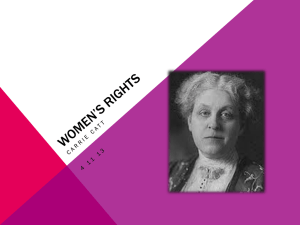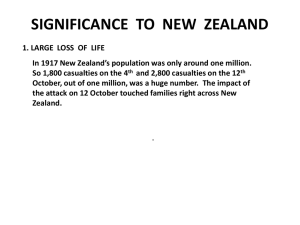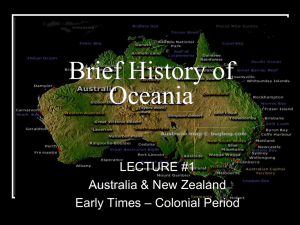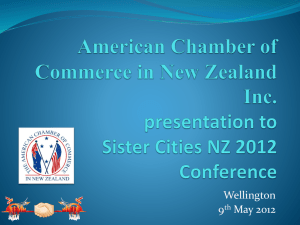Votes for Women! - 4wardthinkinghistory
advertisement
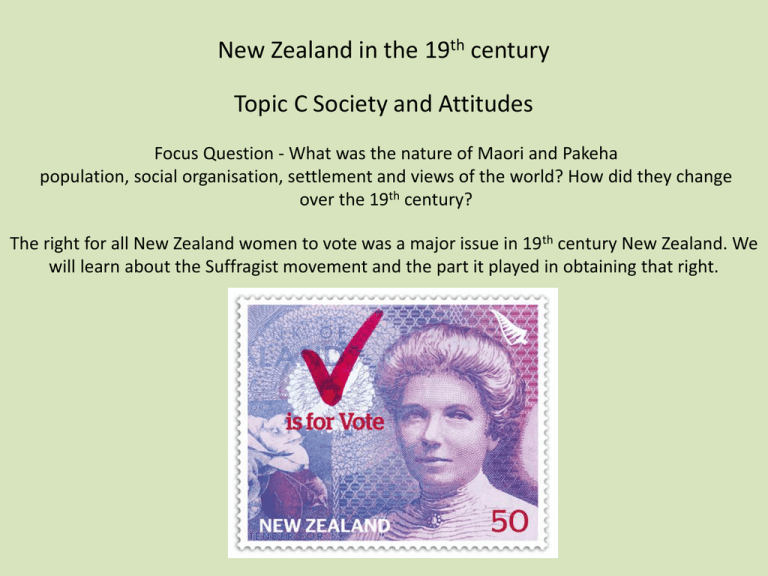
New Zealand in the 19th century Topic C Society and Attitudes Focus Question - What was the nature of Maori and Pakeha population, social organisation, settlement and views of the world? How did they change over the 19th century? The right for all New Zealand women to vote was a major issue in 19th century New Zealand. We will learn about the Suffragist movement and the part it played in obtaining that right. Votes for Women! When the Governor, Lord Glasgow, signed the Electoral Act into law on 19 September 1893, New Zealand became the first country in the world to grant women the right to vote in parliamentary elections. In most other democracies – notably Britain and the United States – women did not win the vote until after the first world war. Why did women need to vote? In early colonial New Zealand, and in other European societies, women were excluded from any involvement in politics. Women, it was believed, were suited to domestic tasks. Only men could handle politics The law of the land stated that the husband or father was the head of the household. On marriage, a woman lost what few civil rights she had. Her property and wages were controlled by her husband. The man of the house represented the family in public life, as only men had the right to vote until 1893. In society where males settled disputes by force the home was no exception. Domestic violence was common and was not acceptable as grounds for divorce. What does this image tell you about the popular view of women voting? A movement emerges The suffrage campaign in New Zealand began as a far flung branch of a late 19th century movement for women’s rights that spread throughout Britain and its colonies, the United States and northern Europe. The movement was shaped by two main themes: equal political rights for women and a determination to use them for the moral reform of society (e.g. The prohibition of alcohol) . In the USA the Women’s Christian Temperance Union was formed. The WCTU was organized by women who were concerned about the destructive power of alcohol and the problems it was causing their families and society Women’s Christian Temperance Union The Women’s Christian Temperance Union established a branch in New Zealand in 1885. Led by Kate Sheppard, WCTU campaigners organised a series of huge petitions to Parliament. 9000 signatures were gathered in 1891, 20,000 in 1892, and finally in 1893 nearly 32,000 - this last representing almost a quarter of the female population of New Zealand . Temperance may be defined as: moderation in all things healthful; total abstinence from all things harmful. A number of New Zealand’s leading male politicians, including John Hall, Robert Stout Julius Vogel, William Fox and Tom Ballance, supported women’s suffrage. In 1878, 1879 and 1887 bills or amendments extending the vote to women (or at least female ratepayers) only narrowly failed to pass in Parliament. Political Manoeuvres At the start of the 1890’s, some men started to resist the idea of women’s suffrage. They felt that to disturb the natural balance of the genders would be catastrophic for society. In addition, the liquor industry feared that women would demand the prohibition of alcohol. Their response to this perceived threat was to lobby sympathetic MP’s and organise their own counterpetitions. Henry Smith Fish, a Dunedin politician, posed a particular problem for the suffragists by circulating antisuffragist propaganda to pubs. However, it was found that some of the signatures were false or obtained by dubious means and so the campaign failed. The Liberal Government of 1891 was divided over the issue. Premier John Ballance was a suffrage supporter, but thought that women might vote for the Conservatives as many of his own party, including Richard Seddon, supported the liquor trade and opposed suffrage. In 1891 and 1892 the House of Representatives passed bills which would have enfranchised all adult women. On each occasion opponents sabotaged the legislation in the more conservative upper house, the Legislative Council, by adding amendments. Victory at last Seddon came to power after Ballance’s death in 1893 and the Suffragists’ hopes waned. A third petition, bearing the signatures of almost 32000 (almost one third of eligible women in the country), was presented and passed in the House, but the battle wasn’t over yet. New anti-suffrage petitions were circulated and Seddon tried some dubious methods to stop the bill. These tactics back-fired when two opposition Councillors, previously antiSuffrage, changed their Votes to embarrass Seddon and the bill was passed by 20 votes to 18 on September 19th 1893. The franchise (the right to vote) was granted to women in New Zealand. Women at the polls Opponents of women’s suffrage had protested that women voters might be hurt or insulted at the polling booths by male voters. However, the 1893 election was reported to be the most well conducted on record. A Christchurch newspaper stated that the streets ‘resembled a garden party’ and that the women’s smiles and dresses ‘lit up the polling booths.’ New Zealand women still had a long way to go to achieve political equality. They would not have the right to stand for Parliament until 1919, and the first female MP was not elected until 1933, her name was Elizabeth McCombs. The number of female MP’s did not reach double figures until the mid 1980’s. A third of all members of Parliament elected at the 2005 general election were female. In recent years, women have held the country’s key constitutional positions: governor-general, speaker of the house of Representatives and chief justice. To date there have been two female Prime Ministers of New Zealand, Jenny Shipley 1997 - 1999 and Helen Clark 1999- 2008. More about Suffrage www.cwa.co.nz/frontierofdreams/ www.nzetc.org.tm/scholarly/ www.ywca.org.nz www.christchurch.org.nz/women/ www.mwa.govt.nz www.elections.org.nz www.nzine.co.nz 1. ‘Standing in the Sunshine’ by Sandra Coney published Penguin Books NZ Ltd Chapters 1 & 2 2.‘Century of Change’ (2nd Ed) by Marcia Stenson & Erik Olssen published by Longman Paul 1997 Chapters 4&5 3.‘Women’s Suffrage in New Zealand’ by Patricia Grimshaw published by Auckland University Press 1972 4.‘The Woman Question – writings by women who won the vote’ selected by Margaret Lovell published New Women’s Press Ltd 1992. 5.‘Women’s Suffrage: a short history of a great movement’ by Dame Millicent Garrett Fawcett published by TC & EC Jack ca 1912 available to read on line 6.‘Frontier of Dreams’ Ed Bronwyn Dalley & Gavin McLean published by Hatchette Livre Nz Ltd 2005 7.‘Maud and Amber: a New Zealand mother and daughter and the women’s cause 1865 – 1981’ by Ruth Fry published by Canterbury University Press 1992 8.Kate Sheppard: the fight for women’s votes in New Zealand by Judith Devaliant published Penguin 1992
